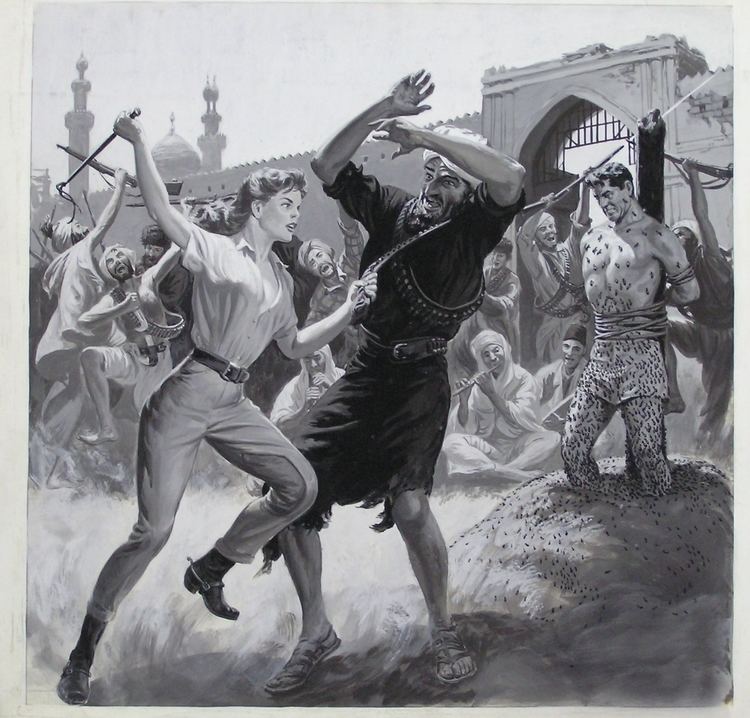Name Norman Saunders Movies Mars Attacks! | Children Zina Saunders | |
 | ||
Died March 7, 1989, Columbus, Nebraska, United States Nominations Hugo Award for Best Dramatic Presentation Similar People | ||
Norman saunders
Norman Blaine Saunders (January 1, 1907 – March 7, 1989) was a prolific 20th-century American commercial artist. He is best known for paintings in pulp magazines, paperbacks, men's adventure magazines, comic books and trading cards. On occasion, Saunders signed his work with his middle name, Blaine.
Contents
- Norman saunders
- Pnp candidate norman saunders
- Early life and career
- Pulp paintings
- Trading cards
- Personal life
- Books
- References

Pnp candidate norman saunders
Early life and career

Saunders was born in Minot, North Dakota, but his earliest memories were from the family's homestead near Bemidji in northern Minnesota where he and his parents lived in a one-room cabin. He recalled moving north at age seven, to Roseau County on the Canada–US border, where his father was a game warden and a touring Presbyterian minister. "A tribe of the Chippewa Indians were there and by the time I was 12, was practically a blood brother."

Saunders' career was launched when his contributions to Captain Billy's Whiz Bang resulted in a job with Fawcett Publications, where he was employed from 1928 to 1934. He explained in 1983 the events that led to his arrival at Fawcett's offices in Robbinsdale, Minnesota:

I was hitchhiking, got into this Model-T Ford with a big trunk strapped up and these two guys in front. One of them had a gun, a rifle. He said, "Keep your eye peeled on the back, kid, see if there are any police or motorcycle cops or something." What the hell was this? These two guys had robbed somebody, or tried to, out in North Dakota, and they had stolen this car from some farmer and were trying to get away. As we got to the outskirts of Bemidji, I was getting awful nervous. There at the town they saw a sand pit with a big hole dug out of it, and they took this car over and got out and pushed it in. They went that way, and I went this way. That night I caught a freight train to Minneapolis. I took a streetcar ride to the end of the line, and there was a two-story bank there and a big sign: "Robbinsdale, the home of Fawcett Publications." I said, "By gosh and by gracious, we got us a real true publisher here!" There was where they were printing Captain Billy's Whiz Bang.
Pulp paintings

He left Fawcett to become a freelance pulp artist, moved to New York City and studied under Harvey Dunn at the Grand Central School of Art. He painted for all the major publishers and was known for his fast-action scenes, his beautiful women and his ability to meet a deadline. He worked in almost any genre—Westerns, weird menace, detective, sports and the saucy pulps (sometimes signed as "Blaine"). He was able to paint very quickly, producing 100 paintings a year—two a week from 1935 through 1942—and thus lived well during the Depression era.

During World War II, Saunders served with the Military Police overseeing German prisoners. Transferred to the Army Corps of Engineers, he supervised the construction of a gas pipeline following the Burma Road. During his off hours, he painted watercolors of Burmese temples.
Trading cards

In 1958, Saunders obtained his first assignment from the trading cards company Topps, painting over photographs of baseball players who had been traded, so that they would appear to be wearing the jersey of their new team. Topps soon employed Saunders to create artwork for many other cards, including the 1962 Mars Attacks series. Product developer Len Brown, inspired by Wally Wood's cover for EC Comics' Weird Science #16, pitched the idea to art director Woody Gelman. Wood fleshed out his and Gelman's initial sketches, and Bob Powell did the final designs. Saunders painted the 55-card set.
The cards were test marketed by Topps through a dummy corporation called Bubbles, Inc. under the name Attack From Space. Sales were sufficient to expand the marketing, and the name was changed to Mars Attacks. The cards sparked parental and community outrage over their graphic violence and implied sexuality. Topps responded initially by repainting 13 of the cards to reduce the gore and sexuality; then, following inquiries from a Connecticut district attorney, Topps agreed to halt production.
Saunders also produced a number of less well known trading-card series, including Ugly Stickers, Nutty Initials, Make Your Own Name Stickers and Civil War News.
Personal life
Saunders married Ellene Politis in 1947. Their daughter, Zina Saunders, is also an illustrator for magazines, books and trading cards. Their son, David Saunders, is a painter-sculptor who designed the "Apple Fence" at New York's Laguardia Airport.
